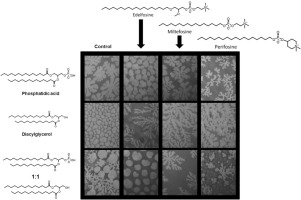当前位置:
X-MOL 学术
›
Chem. Phys. Lipids
›
论文详情
Our official English website, www.x-mol.net, welcomes your feedback! (Note: you will need to create a separate account there.)
Differential impact of synthetic antitumor lipid drugs on the membrane organization of phosphatidic acid and diacylglycerol monolayers.
Chemistry and Physics of Lipids ( IF 3.4 ) Pub Date : 2020-03-14 , DOI: 10.1016/j.chemphyslip.2020.104896 Mark Mahadeo 1 , Elmar J Prenner 1
Chemistry and Physics of Lipids ( IF 3.4 ) Pub Date : 2020-03-14 , DOI: 10.1016/j.chemphyslip.2020.104896 Mark Mahadeo 1 , Elmar J Prenner 1
Affiliation

|
Anti-tumour lipids are synthetic analogues of lysophosphatidylcholine. These drugs are both cytotoxic and cytostatic, and more interestingly, exert these effects preferentially in tumour cells. While the exact mechanism of action isn't fully elucidated, these drugs appear to preferentially partition into rigid lipid domains in cell membranes. Upon insertion, the compounds alter membrane domain organization, disrupt normal signal transduction, and cause cell death. Recently, it has been reported that these drugs induce accumulation of diacylglycerol in yeast cells which in turn sensitizes cells to the drugs. Conversely, phosphatidic acid accumulation appears to protect cells against the drugs. In the current work, the aim was to compare the biophysical effects of the drugs edelfosine, miltefosine and perifosine on monolayers of dimyristoyl phosphatidic acid, dimyristoyl glycerol and an equimolar mixture, to understand how these lipids modulate the mode of action. Surface pressure - area isotherms, compression moduli and Brewster angle microscopy were used to compare drug effects on lipid packing, monolayer compressibility and lateral domain organization of these films. Results suggest that edelfosine and miltefosine have stabilizing effects on all of the monolayers, while perifosine destabilizes dimyristoyl glycerol and the equimolar mixture. Additionally, all three drugs change the morphology of the domains observed. Based on these results the stabilization of diacylgylcerol by edelfosine and miltefosine may contribute to the mode of action as diacylglycerol is a known disruptor of bilayers. Perifosine however does not stabilize diacylglycerol, and therefore cell death may occur through a more direct inhibition of specific signal transduction. These results suggest that perifosine may illicit cytotoxicity through a different mechanism compared to the other antitumor lipid drugs.
中文翻译:

合成抗肿瘤脂质药物对磷脂酸和二酰基甘油单层膜结构的不同影响。
抗肿瘤脂质是溶血磷脂酰胆碱的合成类似物。这些药物具有细胞毒性和细胞抑制作用,更有趣的是,它们优先在肿瘤细胞中发挥这些作用。尽管尚未完全阐明确切的作用机理,但这些药物似乎优先分配到细胞膜的刚性脂质结构域中。插入后,这些化合物会改变膜结构域结构,破坏正常的信号传导,并导致细胞死亡。最近,有报道说这些药物诱导酵母细胞中二酰基甘油的积累,进而使细胞对药物敏感。相反,磷脂酸的积累似乎可以保护细胞免受药物的侵害。在目前的工作中,目的是比较药物edelfosine的生物物理作用,在二肉豆蔻酰基磷脂酸,二肉豆蔻酰基甘油和等摩尔混合物的单分子膜上使用miltefosine和perifosine,以了解这些脂质如何调节作用方式。使用表面压力-面积等温线,压缩模量和布鲁斯特角显微镜来比较药物对这些膜的脂质堆积,单层可压缩性和侧向组织的影响。结果表明,依德福星和米替福星对所有单层均具有稳定作用,而周磷磷使二肉豆蔻基甘油和等摩尔混合物不稳定。另外,所有这三种药物都会改变观察到的结构域的形态。基于这些结果,由于二酰基甘油是双层的已知破坏剂,因此edefosine和miltefosine对二酰基甘油的稳定作用可能有助于作用方式。然而,Perifosine不能稳定二酰基甘油,因此可能通过直接抑制特定信号转导而发生细胞死亡。这些结果表明,与其他抗肿瘤脂质药物相比,periposine可能通过不同的机制引起细胞毒性。
更新日期:2020-03-16
中文翻译:

合成抗肿瘤脂质药物对磷脂酸和二酰基甘油单层膜结构的不同影响。
抗肿瘤脂质是溶血磷脂酰胆碱的合成类似物。这些药物具有细胞毒性和细胞抑制作用,更有趣的是,它们优先在肿瘤细胞中发挥这些作用。尽管尚未完全阐明确切的作用机理,但这些药物似乎优先分配到细胞膜的刚性脂质结构域中。插入后,这些化合物会改变膜结构域结构,破坏正常的信号传导,并导致细胞死亡。最近,有报道说这些药物诱导酵母细胞中二酰基甘油的积累,进而使细胞对药物敏感。相反,磷脂酸的积累似乎可以保护细胞免受药物的侵害。在目前的工作中,目的是比较药物edelfosine的生物物理作用,在二肉豆蔻酰基磷脂酸,二肉豆蔻酰基甘油和等摩尔混合物的单分子膜上使用miltefosine和perifosine,以了解这些脂质如何调节作用方式。使用表面压力-面积等温线,压缩模量和布鲁斯特角显微镜来比较药物对这些膜的脂质堆积,单层可压缩性和侧向组织的影响。结果表明,依德福星和米替福星对所有单层均具有稳定作用,而周磷磷使二肉豆蔻基甘油和等摩尔混合物不稳定。另外,所有这三种药物都会改变观察到的结构域的形态。基于这些结果,由于二酰基甘油是双层的已知破坏剂,因此edefosine和miltefosine对二酰基甘油的稳定作用可能有助于作用方式。然而,Perifosine不能稳定二酰基甘油,因此可能通过直接抑制特定信号转导而发生细胞死亡。这些结果表明,与其他抗肿瘤脂质药物相比,periposine可能通过不同的机制引起细胞毒性。

























 京公网安备 11010802027423号
京公网安备 11010802027423号